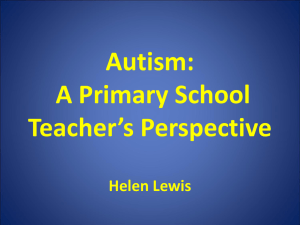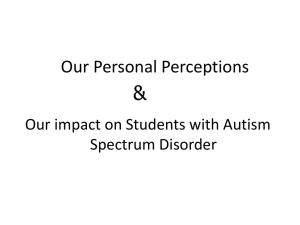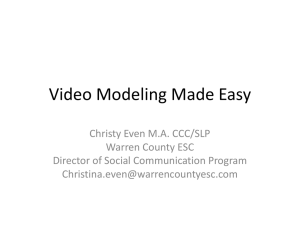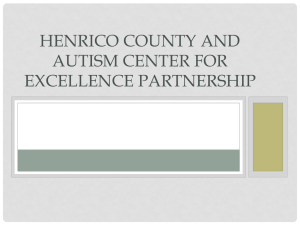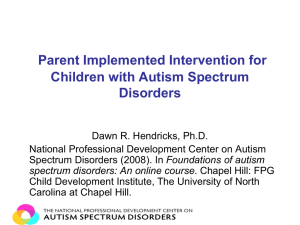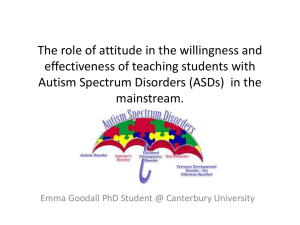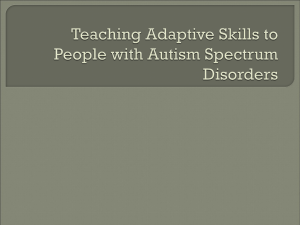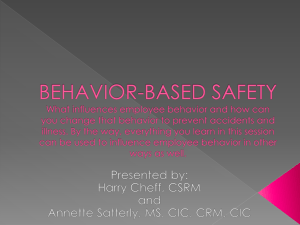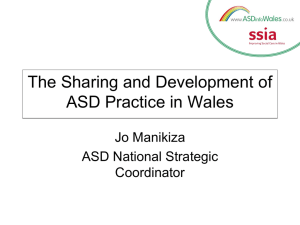Behavior Interventions*HELP!!
advertisement
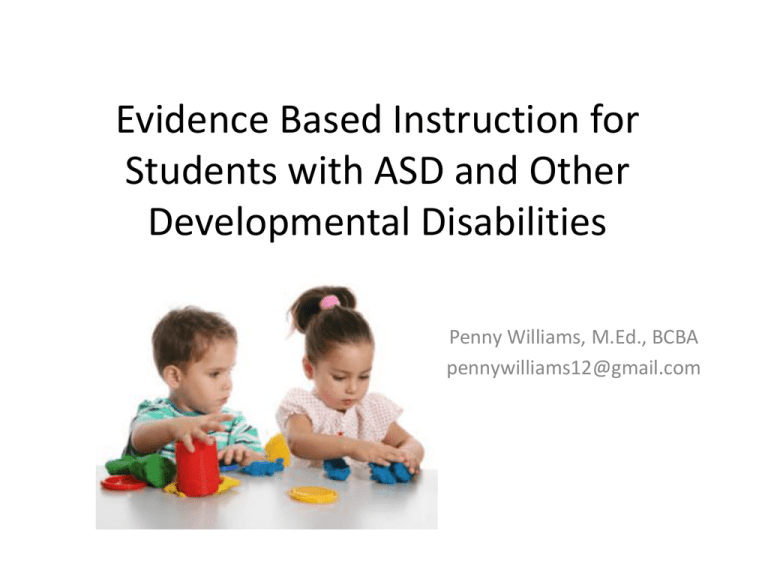
Evidence Based Instruction for Students with ASD and Other Developmental Disabilities Penny Williams, M.Ed., BCBA pennywilliams12@gmail.com The Labels ASD CDD Asperger Syndrome PDD PDD-NOS DSM-V changes for ASD • No Asperger or PDD NOS diagnosis (subsumed under the ASD category) • Two Domains: persistent social communication and social interactions (socialemotional reciprocity, nonverbal communication, developing and maintaining relationship); restricted and repetitive patterns of behavior (stereotypy, excessive adherence to routines, highly fixated interests, hyper/hypo reactive to sensory input) Social Communication Disorder • (SCD) is an impairment of pragmatics and is diagnosed based on difficulty in the social uses of verbal and nonverbal communication in naturalistic contexts, which affects the development of social relationships and discourse comprehension and cannot be explained by low abilities in the domains of word structure and grammar or general cognitive ability. What do we know about ASD? Majority have other neurological differences Many children make remarkable gains with intensive intervention 1 in 88 There is no one right way to teach a student with ASD Outcome must be supported by data Causes of Autism: What we know and don’t know Also an environmental component (but we don’t know what it is yet) Clearly a genetic component 1 in 88 5 times more common in males No known cure Social Deficits: What You Might See Behavior challenges may be related to the lack of interest of social praise/ consequences More interactive with adults (vs. peers) Inappropriate interest in others Lack of understanding of nonverbal information (gestures, facial expressions) Wants friends, but not successful May have low interest in others Communication: What You Might See Behavior problems because of limited language Nonverbal or low verbal Children with very good language, but odd uses: pronoun reversals, strange uses of words. Children with very good language, but odd uses: pronoun reversals, strange uses of words. “scripting” Repetitive, unimaginative play or no play Stereotypy: What You Might See Behavior problems around obsessions Tantrums and other behavior problems around routine changes Hand flapping, vocalizing, spinning, Obsessions with trains, maps, letters, etc Lack of interest in “normal” childhood activities Self-injurious behavior Other Challenges Obsessions can be challenging to overcome Often misinterpret information Non Compliance Emotion Regulation Odd verbal behaviors (prosody, inflection) 10 What about Executive Functions? Executive Functions help with • • • • • • Thinking Acting Solving Problems Learning new info Remembering Retrieving info Looks like…. Pay attention to minor details, but fail to see big picture Difficulty Maintaining Attention Impulse Control Challenges Difficulty Organizing Thoughts Difficulty with Self Regulation Why is school so challenging for children with ASD? • Groups • Sometimes inconsistent Classrooms Environments • Fast moving • Always Changing • Social • Verbal Activities Classroom Challenges • Insistence on sameness/difficulty with changes in routines • Difficulty learning in large groups • Poor organization skills • Poor writing skills • Poor concentration • Vocab usually good, comprehension poor Classroom Challenges • Inability to make friends • Difficulty with reciprocal language • Low frustration tolerance • Poor coping strategies • Emotional vulnerability • Problem solving abilities tend to be poor What can you do about the possible mismatches? Think of Behavior as communication Do not work on everything at once! Children with ASD are children first Adjust Environment To: Make communication easier Meet a need Add a preference Remove some distracters The Environment • What is the purpose of environmental arrangement? Foster Independence Greater Staff Efficiency Decrease Challenging Behavior Facilitate Social Interactions Increase Predictability The Environment: Ideas Do instructional areas have clear visual boundaries? • Bookshelves used to define reading areas • Tables for small groups • Areas for individual instruction (if needed) Are materials organized and easily accessible? • Materials labeled • Shelves not overstocked Are rules posted • For children • For staff • Words and pictures Reinforcement Token Systems Visual Supports Instruction Teaching Tools What is it that motivates a student to try when something is hard? What is the schedule of reinforcement—or how often do they need to be motivated? It begins and ends with motivation How to keep it as natural as possible. Fading and Delaying Reinforcement What is Reinforcement? Something that immediately follows a behavior and increases the likelihood that that behavior will happen again. 23 Reinforcement is not a bribe! A reinforcer is a stimulus that increases likelihood of behavior occurring again, and is presented AFTER behavior occurs A bribe does not guarantee the increase of behavior and is presented DURING a behavior or as a “carrot” 24 Choosing Reinforcers •Reinforcers are individual •Use natural reinforcers whenever you can Get out of Homework Pass Name____________ Date____________ Good for one subject on any day. 15 Minute Free Time Card Name_________________ Date__________________ Good for one use only. When time is up, I will go back to work. Schedules of Reinforcement Goal: Natural Less available over time Thick to Thin Reinforcement Token Systems Visual Supports Instruction Teaching Tools Prompting—What is it? Something that occurs before a response and increases the likelihood of a correct response Prompting before a response minimizes errors Types of Prompts Verbal Model Pictorial Gestural Environmental Physical Breaks a skill into very small parts Provides concentrated teaching Discrete Trial Training Response is initiated by teacher A response by the child is required General Instructional Considerations • Never assume the student CAN do a task/activity—is there a skill deficit? • Have you given enough processing time? • Have you broken down the skill enough for the student to understand? • Are you providing enough practice? 33 Reinforcement Token Systems Visual Supports Instruction Teaching Tools A strategy that really works…. Verbal info Visual Supports Schedules may……….. Provide the following info: Help: • Change in activities or new activities • When events will happen • When it is time to move to next activity • Establish concept of being finished • Set expectations • Decrease “surprises”- reduce anxiety • Establish routines How was my day? Great Okay Will work on it (2 points) (1 point) (no points) Followed directions Completed Work Kept it together Total Points:____________ First Then Scheduler Visual Schedule Planner Student: Alexander 1. Get pencil 2. Get folder 3. Open folder 4. Take out worksheet 1 5. Complete worksheet 1 6. Take out worksheet 2 7. Complete worksheet 2 8. Put worksheets in folder 9. Close folder 10. Put folder away Date: September 14th Visual Timer timetimer.com Regulating Arousal States 48 49 Recess Schedule 1. 2. 3. 4. 5. 6. Choose one friend to play Ask friend to play Choose a game Play for 10 minutes Thank friend for playing Make a choice 50 51 52 How to Look Like a Student at My Desk Sit at my desk with my mouth and feet quiet. If I need to I can sit on my feet or stand at my desk. My hands can be doing school work by writing or reading. I can do my writing with my pencil and I can read the books in my desk. I can ask for help if I need to. I will follow my teachers’ directions. When my teachers ask me to do something I will listen and follow their direction. If something is hard I need to try, but I can ask for help. I am working on I am working on: keeping my hands to myself (not touching others) Did I do it? Yes Yes Yes Yes Yes Yes Yes 5 No No No No No No No I am earning: 15 minutes on computer I am working on: keeping my hands to myself (not touching others) Did I do it? Yes Yes Yes Yes Yes Yes Yes No No No 5 I am earning: 15 minutes on computer No No No No Challenging Behavior Self Injury or injury to others Damage to the environment Challenging Behavior Interferes with learning Interferes with socializing What is Positive Behavior Support? Assumes all challenging behaviors have a function Emphasizes: • Prevention • Instruction of appropriate alternative behaviors Improves quality of life for student and family Understanding the function of behavior: Behavior is lawful When we understand why a student is demonstrating a behavior, we say that we understand the function of that behavior What does the “function” of the behavior mean? Obtain • Attention • Tangible • Sensory Escape • Attention • Tangible • Sensory Stress and ASD • As many as 84% have an anxiety disorder • Levels of endorphins significantly higher in ASD than typicals • Anxiety leads to social withdrawal, repetitive movements, difficulty with attention and cognitive function, easy to arouse/anger, impaired memory, poor decision making, difficulty to calm Accommodations for Work Output Clear Expectations • Concise Language (keep it simple) • Pictures/Symbols/Written as much as possible Modifications • Highlight, circle, shorten, break down • Fidgets, seating modifications Check Ins/Monitoring • May need help to get started • May need assistance to keep going Writing • “having to engage in handwriting is the most significant and serious impediment to academic participation for students with autism spectrum disorders in schools in North America today. (Dr. Richard Simpson, 2007) • multiple tasks (printing and thinking) leads to “a system wide resource constraint”—blood and oxygen for each component task are reduced and coordination of brain decreases Hand Writing Accommodations • Permit student to verbally express information and tape record it • Allowing the student to state information to a scribe • Modify assignments/tests to incorporate multiple-choice, fill-in-the-blank, matching, and/or short-answer questions • Computer, laptop use • Allow student to underline or highlight answers to questions in reading passage • Supply student with a teacher-made outline of main ideas and key points from readings and/or presentations “Home Base” A place the student can go to… • Plan/review daily events • Escape stress of a current environment • Regain control if needed (meldown, tantrum) Important that student recognizes home base as: • A predictable and positive place • Not presented used as a time out Amount of time in home base: • Some students may need more time initially • Some activities may be scheduled daily (social skills) Key Concepts •Twice as much “Asperger time half as much Time” done Manage Anxiety •Changes…… •Setting Events General Considerations… Work and Directions • Tasks and skills broken down? Task lists? • Amount of work? Hand writing accommodations? Directions • Have you given enough processing time? • Avoid overloading student with too much verbal information—can you use gestures/visuals? Reinforcement and Visuals • Is motivation considered? Lots of Praise • Schedules, social scripts, behavior cues? What Else? Consider Sensory needs • Built in schedule of sensory activities • Accommodations (seating, group work, etc.) Physical and Health needs • Food intake, bathroom habits, fatigue • Temperature, clothing, odors, etc. Any scheduling changes? • Too tired in the am? • Crowded environments More….. Collaboration • Work together to uncover/discover, teach and prevent • Planned meetings/check ins with team members Social Skills and Behaviors • Functions • Instruction (skill development and bullying/teasing info) Some Important Resources • Autism Society of America • Aspergersyndrome.org • do2learn.com, speakingofspeech.com • polyxo.com, abaresources.com Some Key Skills To Target Communication • Make requests • Protest appropriately • Conversation skills Emotions and Arousal States • Identify emotions in self and others • Identify arousal states in self • Learn how to self-regulate emotional states Problem Solving/Beginning Perspective Taking • Develop strategies to cope with emotions • Problem solving skills with peers and adults • Perspective taking and inferences Basic Skills: Teach…….. Appropriate Requests Appropriate Protests Provide structure Other beginning skills to consider…. Tolerate new demands/tasks Following directions Delay reinforcement Wait Accept interruptions Accept endings/transitions Stay on task Intermediate Skills: Teach…… Identify emotions Identify arousal states Identify and implement coping strategies Other emotion regulation skill examples Dealing with mistakes Understanding impact of unkind behavior Accepting no as a consequence Asking for help Using nice words Compromising Reading body language Beginning Conversation Skills Responding to Greetings and Closures General responding (what?, okay, oh really) Initiating Greetings and Closures Comments (look, I did it, that’s fun) Mands (move, let go, give me___) Sentence Stems (I see, I have, It’s a) Yes/No Intermediate Conversation Skills Social Questions (name, age, where you live) Subjective Questions (favorite food, movie, etc.) Asking Questions Statement/Statement Statement/Question Talking to My Friends When I am playing with my friends I need to talk to them. I will ask _______ questions. I will make ______ comments. Additional Instructional Activities Conversation Topics Conversation Topics: Alex can choose a topic to talk about. Teacher will support him with coming up with details about the topic (i.e. Beach: sand, water, digging, fun) Alex may need to choose a topic from a list Topic:______________________________ Details: 1.____________________________________________ 2.____________________________________________ 3.____________________________________________ 4.____________________________________________ 5.____________________________________________ Advanced Conversation Skills Nonverbal Language (proximity, voice volume, gestures) Shifting Topics Listening Skills Maintaining Conversations Appropriate interruptions Initiating Conversations Idioms, humor, private/public topics
